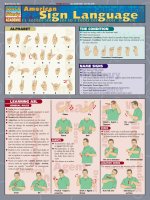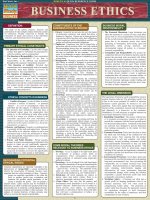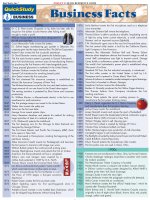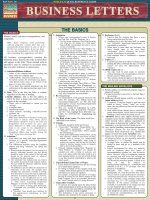BarCharts quickstudy c++ guide
Bạn đang xem bản rút gọn của tài liệu. Xem và tải ngay bản đầy đủ của tài liệu tại đây (1.09 MB, 4 trang )
BarCharts, Inc.®
WORLD’S #1 QUICK REFERENCE SOFTWARE GUIDE
THE ULTIMATE GUIDE TO C++ A PROGRAMMING LANGUAGE.
Introduction
This Chart Assumes That All Readers:
1. Have a general understanding of programming
languages.
2. Understand the PC / Wintel environment.
The Programming Process
These are the five simple steps to follow when
developing a program:
1. Decide what the program’s primary function will be.
2. Decide how the program will execute.
3. Develop the code properly.
4. Test the program.
5. Compile the program.
What is C++?
C++ is a programming language which evolved
from C and was developed by AT&T in the 1980s. It
is a structured programming language designed to
build large programs out of smaller programs.
The program is rather small with only 74 keywords,
but it has one of the largest assortments of operators.
C++ does not have any input or output statements.
Instead, it has a library of standard I/O functions
allowing any computer or device that conforms to
C++ standard to execute the program.
Note: This chart is based on a specific C++
compiler. There is no difference in coding between
this compiler and all other marketed compilers.
Basic C++
Definitions
Compiler: converts code into low level machine
instruction.
Logic Error: an error difficult to find, the computer
cannot find them.
Literal: a constant value stated in the program.
Operator: characters that perform specific functions.
Syntax Error: an error in the code stucture (i.e.
spelling).
Variable: a defined value that holds changeable data.
Basic Lines of Code:
There are at least six lines of code that will appear in
every C++ Program:
1. //Filename: FILENAME.CPP
2. //Comment about what it does.
3. #include <iostream>
4. using namespace std;
5. void main()
6. {
7. cout << “Hello World.”;
8. }
Line 1: designates the name of the file.
Line 2: comment that gives a short explanation of
what the file is for.
Line 3: a statement making reference to an existing
library. This statement asks the compiler to include
the existing library in the compiling process. This
library can be one from the standard library or from
a recent development.
Line 4: this is needed to make the I/O facilities available.
Line 5: the main() function defines where the rest
of the program will stem from. The void before
main() should be taken as a given, until a working
knowledge of the program exists.
Note: main() is a function. Once it is defined
another cannot be defined until the main()
function ends.
Line 6 and 8: the opening and closing braces for the
entire program. All coding for the main() function
will exist inside these braces.
Line 7: the only line that will do anything when the
file is executed. It represents the code for main().
Comments
Comments are placed to the right of a line of code.
They are designated by a //. The comments are used
to explain what is happening within the program.
Numbers and Characters
Data Types
In C++ a progammer must specify the type of
information (data) that is to be placed within the
variable. C++ has 16 designated data types :
Declaration Name Data Type Description
char
Character
unsigned char
Unsigned character
signed char
Signed character (same as char)
int
Integer
unsigned int
Unsigned integer
signed int
Signed integer (same as int)
short int
Short integer
unsigned short int Unsigned short integer
signed short int
Signed short integer (same as
short int)
long
Long integer (same as int)
long int
Long integer (same as long)
signed long int
Signed long integer (same as
long int)
unsigned long int Unsigned long integer
float
Floating-point (Real)
double
Double floating-point (Real)
long double
Long double floating-point
(Real)
Data Type example: char initial;
Each data type has a specific range of characters
which it can occupy. The table below explains each
data type’s range:
Data Type
Range
char
-128 to 127
unsigned char
0 to 255
signed char
-128 to 127
int
-2147483648 to 2147483647
unsigned int
0 to 65535
signed int
-2147483648 to 2147483647
short int
-32768 to 32767
unsigned short int 0 to 65535
signed short int
-32768 to 32767
long int
-2147483648 to 2147483647
signed long int
-2147483648 to 2147483647
unsigned long int 0 to 4294967296
float
-3.4E38 to 3.4E+38
double
-1.7E308 to 1.7E+308
long double
-1.7E+308 to 1.7E+308
float
-1.7E+308 to 1.7E+308
double
-1.7E+308 to 1.7E+308
long double
-1.7E+308 to 1.7E+308
Adding Expressions to Variables
Now that the variable has been designated as a specific
data type, an expression is assigned to the variable. An
expression is assigned to a variable with the operator
‘=’. The format of assignment looks like this:
variable = expression;
The expression can be assigned when defining the
variable or later in the program.
Constant variables are variables that cannot change
during the program. To designate a variable as a
constant follow this example:
const int day = 5;
The constant variable expression must be assigned
when defining the variable.
Character Literals and String Literals
C++ designates character literals as a single character
between single quotation marks: ‘1’.
If the character literal does not have single quotation
marks around it, C++ will think the program is
defining a variable. C++ programs can define a
variable with another variable. For example:
char initial;
initial = ‘A’
initial = firstLetter
A string literal is one or more characters between
double quotation marks, i.e. “mike”.
C++ places a null zero (\0) at the end of a string literal
during compiling to designate the end of the string. If
the null zero is not added, the string end and the
program will not know where the string ends. This is not
necessarily a problem, but it may add memory space.
1
Escape Sequences
An escape sequence informs the program that the
following character(s) is (are) a special control
character. The backslash (\) operator represents an
escape sequence. The following characters may be for
an ASCII character or for a special escape sequence
character. The following list displays all special escape
sequence characters:
Escape Sequence Meaning
\a
Alarm (a beep from the
speaker)
\b
Backspace
\f
Form feed (new page on
printer)
\n
New line (carriage return and
line feed)
\r
Carriage return
\t
Tab
\v
Vertical tab
\\
Backslash (\)
\?
Question mark
\’
Single quotation mark
\”
Double quotation mark
\000
Octal number
\xhh
Hexadecimal number
\0
Terminator (or null zero)
cout and cin
cout and cin are defined in the IOSTREAM.H.
When the IOSTREAM.H library is included, I/O’s
with cout and cin are possible.
cout is for data output and cin is for data input.
They are pronounced “see out” and “see in”.
The insertion operator (<<) is used with cout and the
extraction operator (>>) is used with cin.
cout and cin examples:
cout << “Hello world!”;
cin >> Name; // Waits for users input
Output Options:
All float data types cout a certain number of digits. If
the value was 7.8 the cout would be 7.800000. The
answer is correct, but the extra zeros get in the way.
An I/O manipulator changes the way cout works. The
output manipulator precision() limits the number of
digits output for less precision. This is an example for
a cout of 7.80:
cout.setf(ios::fixed);
cout.setf(ios::showpoint);
cout.precision(2);
cout << 7.8;
To set a fixed decimal point in any program the
only item in the above example that will ever change is
the (2) in line 3, depending on the number of decimal
places needed.
An easy way to right justify the cout output is with the
width() manipulator. Simply add the highest number of
digits beginning output in-between the parentheses:
cout.width(10)
cout << 543 << end 1;
cout.width(10)
cout << 12345678 << end 1;
cout.width(10)
cout << 746782 << end 1;
Output:
One difference between width() and precision() is
that precision() will stay throughout the program
unless otherwise changed and width() must always be
reentered.
Input Options:
If the cin requests more than one answer on one line,
the user has three different options for placing the
information, but each answer must be separated by a
space. The user can type an answer and hit the space bar,
tab key or return key before entering the next answer.
Operators
C++ has a large number of operators to assist in the
simplification of code. Operators are read in order of
precedence. If two operators are of the same precedence,
the file reads from left to right. The following is a full list
of all operators in order of precedence:
Precedence Level
Symbol Description
1
::
C++ scope access / resolution
2
( )
Function call
[]
Array subscript
->
C++ indirect component selector
.
C++ direct component selector
3 Unary
!
Logical negation
~
Bitwise (1’s) complement
+
Unary plus
Unary minus
&
Address of
*
Indirection
sizeof Returns size of operand in bytes
new
Dynamically allocates C++ storage
delete Dynamically deallocates C++ storage
type Typecast
4 Member Access
.*
C++ class member dereference
->*
C++ class member dereference
()
Expression parentheses
5 Multiplicative
*
Multiply
/
Divide
%
Remainder (modulus)
6 Additive
+
Binary plus
Binary minus
7 Shift
<<
Left shift
>>
Right shift
8 Relational
<
Less than
<=
Less than or equal to
>
Greater than
>=
Greater than or equal to
9 Equality
==
Equal to
!=
Not equal to
10
&
Bitwise AND
11
ˆ
Bitwise XOR
12
|
Bitwise OR
13
&&
Logical AND
14
||
Logical OR
15 Ternary
?:
Conditional
16 Assignment
=
Simple assignment
*=
Compound assignment product
/=
Compound assignment quotient
%=
Compound assignment remainder
+=
Compound assignment sum
-=
Compound assignment difference
&=
Compound assignment Bitwise AND
ˆ=
Compound assignment Bitwise XOR
|=
Compound assignment Bitwise OR
<<=
Compound assignment left shift
>>=
Compound assignment right shift
17 Comma
,
Sequence point
Code Snippet:
int age = 5;
age += (-5+11)/6+2;
cout << “In three years I will be
“ << age << endl;
Output:
if / else command
Following are some of the most useful operators:
Unary and Binary Operators
Unary operators define a single value while binary
operators operate on two values. For example:
int number = -1
int number2 = 1 - 2
In the first line of this code, the unary “-” makes “1”
a negative number. In the second line of code, the value
of variable number2 uses a binary operator “-” to
find the sum of two numbers.
Assignment Operator
The “=” sign is the assignment operator. As shown in
other sections, it assigns a value or expression to a
variable. Multiple assignments can be used to shorten
code. For example:
age1 = 21;
age2 = 21;
age3 = 21;
or
age1 = age2 = age3 = 21;
Note: The above example is an interesting way to
shorten code, but code is still more understandable
when avoiding multiple assignments.
Compound assignment operators are designed to
simplify the adjustment of variables during program
execution. A compound assignment operator takes the
variable on the left and subjects it to the value on the
right, giving a new value for the variable.
For example:
b = b + 100;
or
b += 100;
Both statements above produce the same answer.
Adding and Subtracting One
The increment and decrement operators are similar to
compound assignment operators. The variable is subject
to an increase or decrease of 1. For example:
int q = 17;
++q;
or
int q = 17;
q++;
or
int q = 17;
q += 1;
or
int q = 17;
q = q + 1;
All four examples will produce the same answer, 18.
Typecast Operators
Typecast operators change a variable from one data
type to another. A typecast operator is an existing data
type with the keyword static_cast. For example:
static_cast<int> (q)
When placed in C++ code, the operator looks like this:
int q = 17;
int answer;
float c = 8.7;
answer = q + static_cast<int> (c);
In the above code, the value for variable answer
must be an integer. To ensure this, the author
typecasted float c, which will remove all decimal
places. Truncate is the term used for removing or
eliminating part of an answer.
The sizeof() Operator
sizeof() is not a function. It is an operator designed to
determine how many memory bytes are needed to hold
the value of a variable. For example:
memoryHeld = sizeof(float);
This line will hold the amount of memory required
for a float.
Logical Operators
Logical operators (i.e. &&, ||, and !) add
capabilities to if statements (next column). These
operators combine the actions of two or more relations.
For example:
if (age < 5 || age > 10)
2
All programming languages have if statements. In
C++, if statements are designed to test operators.
The answer from an if statement will determine
which part of the program to execute next. Most if
statements are based on relational test such as:
if (int x < 22)
{a block of one or more C++
statements here}
Note: Indenting the block of statements in the
above example is not necessary, but it is easier to
find if statements this way.
The else statement will tell the program what to do
when an if statement is false. Add the else statement
after the if statement’s closing blocks like this:
if (int x < 22)
{a block of one or more C++
statements here}
else
{a block of one or more C++
statements here}
if/else statements only have one or two options
(true or false). Nesting statements make the program
choose between three or more potential options.
Nesting statements means placing a statement inside
of a statement.
Code Snippet:
void main()
{
int age;
cout << “How old are you?”;
cin >> age;
if (age <= 10)
{
if (age == 7)
cout << “You are 7 years old.”;
else
cout << “You are younger than
10, but not 7 years old.”;
}
else
{
cout << “You are older than 10
years old.”;
}
}
Output:
Arrays
An array is a defined number of memory slots for a
variable’s value. For example:
char yourName[4] = “Don”;
When the array is placed in memory it looks like this:
[0]
D
[1]
o
[2]
n
[3] \0
Note: Make sure space is left for the null zero (page 1).
Note: After defining these memory slots, the value
cannot exceed the array, otherwise the extra digits or
characters will be removed.
When using an array, it is easy to edit a letter of the
expression. If Don’s name was Dan, the editing code
would look like this:
yourName[1] = a;
This code will edit the letter in the [1] spot of
memory held by yourName.
When defining an array, if the expression is known
when defining the variable it is not necessary to place
a number between the array subscripts, but the
expression must be assigned at that time. If not, the
program assumes that the array is nothing.
switch Statements
if/else statements are best used with C++ code
which must choose between two options. In an earlier
section (page 2), nested if/else statements were
discussed. The problems with if/else statements
are:
1. The more nesting is used, the closer the code gets
to the right margin.
2. Changing an extensive nested if/else
statement is not easy.
This is where switch statements come in handy. A
switch statement works the same as an if/else
statement, by testing values using relationship
operators. The main differences are:
1. Switch statements only search for one matching
answer. Once the answer is found, the program
stops looking.
2. If the program has no matching answer, the default
statement is used. The default statement is added
by the user.
3. When editing the statements, it is easier to make
changes to switch statements when compared to
nested if/else statements.
4. A switch is controlled by just one integer or
character value instead of a logical test.
Here is an example of a switch statement:
void main()
{
int age;
cout << “How old are you?”;
cin >> age;
switch (age)
{
case 1 :
{
cout << “You are 1 year old.”;
break;
}
case 2 :
{
cout << “You are 2 years old.”;
break;
}
case 3 :
{
cout << “You are 3 years old.”;
break;
}
default :
{
cout << “You are older than
3 years old.”;
}
}
}
Output:
Loops
A loop is the repeated execution of the same set of
programming instructions. To stop the repeat, a variable
must be added, otherwise the program will loop
infinitely. The count variable in a control relationship
is the standard variable used to stop a loop.
The while Loop
A while Loop uses a relationship test to stop it from
looping. Once the relationship is false, the loop is ended.
The following example prints Quick Study 5, times:
int count = 0;
while (count < 5)
{
cout << “Quick Study” << endl;
count++;
}
The fifth line of code in the above section is very
important. Each time the loop repeats, ‘1’ will be
added to the variable count. When count reaches 5,
the loop will stop. The ‘++’ is the increment operator
(discussed on page 2).
The do – while Loop
Use the do - while Loop when the body of the
loop must repeat at least once during execution. An
iteration is a cycle throughout a body of the loop. The
difference between a while Loop and a do while
Loop is where they test their control
relationship. The while Loop tests at the beginning
and the do - while Loop tests at the end of the
code body.
The following is an example of a do - while Loop:
// FILENAME: DOWHILE.CPP
// An example of a do - while loop.
#include <iostream>
using namespace std;
void main()
{
float height;
do
{ cout << “How tall are you?”;
cin >> height;
if ((height < 3.5) || (height >
9.5))
{cout << “You can’t be that
size!” <
<<
“Tell
me
the
truth...”;
} while
((height
<
3.5)
||
(height
>
9.5));
if (height < 4.5)
{ cout << “You must be at least
4.5 feet tall to go on this
ride.” << endl;
cout << “Sorry!” << endl;
}
else
{ cout << “Enjoy the ride.”;
}
return;
}
Output:
Note: If the programmer sets up a switch statement
with upper case characters, the user must type upper
case characters into the cin prompt. Switch does
not perform upper and lower case conversions.
The break Statement
In the above example the break command appeared
at the end of every case. This causes the program to
go to the end of the switch statement. If the break was
not there, the output would be:
Assuming the user typed a 1:
You are 1 year old.
You are 2 years old.
You are 3 years old.
You are older than 3 years old.
Assuming the user typed a 3:
You are 3 years old.
You are older than 3 years old.
QUICK
TIP
endl stands for end line.
This command, placed at the
end of a cout, forces a
hard return when the
program is executed.
3
for Loop
for Loops are more complicated than the while
Loops. To control a single for
Loop the
programmer needs three expressions. The following is
the format of a for Loop:
for (startExpression; conditional;
countExpression)
{
// Block of one or more C++
statements.
}
Note: Semicolons end all statements. It is required for
for statements to use them to split the three
expressions. All three expression are actually
statements inside the for statement.
Code Snippet:
for (down = 5; down >= 1; down--)
{
cout << down << endl;
}
Output:
The for Loop statement is not much different than
that of the while
Loop statements. The
startExpression is executed before the loop begins, and
the countExpression is done at the end of the body
before testing the loop condition again.
Nested Loops
Nested loops are similar to any nested statement. The
nested statement is controlled by the outer statement.
This adds power to the loop. An example of a nested
loop is a car’s tripmeter. Each set of numbers on the
tripmeter represents a nested loop. The loop below will
add just like a tripmeter:
for (sand = 0; sand <= 9; sand++)
{for (dred = 0; dred <= 9; dred++)
{for (ten = 0; ten <= 9; ten++)
{for (mile = 0; mile <= 9;
mile++)
{for (tenth = 0; tenth <=
9; tenth++)
{cout << sand << dred <<
ten << tenth << endl; }
}
}
}
}
break Command
The break command will stop a loop before it would
normally end. A break command only works on loops
and switch statements. An example using a break
command was shown in the first column of this page.
Note: The exit() function will stop the program
wherever the exit() is. To use the exit() function, the
STDLIB.H file must be included.
return Command
The return command will stop a function before it
would normally end. An example using a return
command was shown in the second column of this page.
continue Command
The continue command is the opposite of a break
command. The continue command jumps back to the
loop’s start, skipping the rest of the statements in the
loop body. In the following example the rae line will
never execute, but the loop will repeat five times:
for (up = 0; up >= 5; up++)
{
cout << “doe” << endl;
continue;
cout << “rae” << endl;
}
Functions
Sharing Variables
Advanced Functions
Functions are a good way to break down a program.
C++ was designed to create large programs from little
programs. Each function should be a self-contained
mini-program. Mini-programs aren’t necessary, but
will help the organization of programs.
Note: A structured program is set up with a single
function for every task.
The main() function, in a perfect program, should
only be a starting or controlling function for all other
functions.
All new functions must be defined during the
function in which it will be used. When a function is
used in another it is referred to as “calling”. When
C++ calls a function, the new function gains control
until the code has been read, then the original function
regains control until the next function is called.
Note: Calling functions could create the same problem
as an infinite loop. If one function calls itself or if two
functions call each other, that is called recursion.
Recursion may cause the program to never end.
Some pre-made functions need special #include
lines at the top of the program. For example,
strcopy() needs this statement:
#include <string.h>
Data or values can be shared (passed) between two
functions. The value being passed is called an
argument. The receiving variable is called the
parameter. To define the passed value in a new
function, the parameters must be placed, in
parentheses, on the new function’s definition line.
The definition line is the first line of the function.
This is an example of value passing:
FindMe (p4, p5);
// ...and later on in the program
void FindMe (p4, p5)
{
The first line of the above example calls for the
FindMe function and passes two values. Line two
separates two functions. Lines three and four are the
first two lines of the FindMe function.
All functions in C++ must have a prototype. A
prototype is what declares a function. The prototype
is usually placed at the top of the code, before main().
The #include line at the beginning of all
programs is a header file. These header files are
prototypes for library functions, such as, strcpy().
There are three different ways to pass values and
expressions from one function to the next:
1. by value
2. by address
3. by reference
Passing by Value
In this form of passing, the value is passed on to the
next function, but the variable is not. If any changes
occur to the value once it has been passed, the changes
will not affect the original variable. The receiving
function looks at this value as if it were a local value.
Passing by Address
Passing by address means that the entire variable is
moved from one function to the next. An address is a
variable’s location in memory. Address passing is
most useful when passing an array. The address held
by the array will also move.
Passing by Reference
This form of value passing is designed to pass non-arrays.
Reference passing works the same as address passing
except reference passing doesn’t work with arrays.
Code Example:
#include <iostream>
using namespace std;
void GetValue(int height);
void GetAdd(char name[10]);
void GetRef(int &age);
void main()
{
int height;
char name[10];
int age;
cout << “How tall are you?”;
cin >> height;
cout << “What is your first
name?”;
cin >> name;
cout << “How old are you?”;
cin >> age;
GetValue(height);
cout << “In six years you may
still be” << height << “.” <<
endl;
GetAdd(name);
cout << “In six years you will
change your name to” << name <<
“.” << endl;
GetRef(&age);
cout << “In six years you will be”
<< age << “years old.” << endl;
return;
}
Return Values
The return statement was discussed earlier in this guide.
The return statement not only stops a function
prematurely, but can also take a value. It is possible to pass
more than one value from one function to another, but it is
not possible to return more than one value from a function.
The data type must be placed in the prototype of all
returning functions. If there is no value, the program
assumes it is an integer. If there is no returning value,
the function prototype must start with void.
Here is an example of a return value:
int RemoveAge(int age);
void main()
{
int ageDif = 0;
int age;
cout << “How old are you?”;
cin >> age;
ageDif = RemoveAge(age);
cout << “You have << ageDif
<< “until you are 100
<< “years old.” << endl;
return;
}
Local and Global Variables
Any variable can be placed inside any function in any
program. When a variable is defined inside a function,
it is considered a local variable. A local variable only
exists while its defining function’s block exists. A
function block is the code between a function’s
brackets. This is an example of a local variable:
void main()
{
int money = 5;
}
Integer money is a local variable to function main().
After the second bracket, function main ends, and
integer money stops existing.
Global variables are defined after a function ends and
before the next function begins. Usually, a global
variable is defined before the main() function. These
functions will exist from their defining point to the end
of the program. They can be used by any function during
the program. This is an example of a global variable:
int money = 5;
void main()
{
}
Global variables are very visible to all functions,
whether the functions need the variable or not. A local
variable places functions on a need-to-know basis.
Code Example:
#include <iostream.h>
int drinkAge = 21;
void main()
{
int yourAge = 15;
cout << “You are” << yourAge <<
“and not old enough to drink,” <<
drinkAge << “.” <
int momAge = 38;
cout << “Your mom is” << momAge
<< “. She is old enough to
drink” << drinkAge << “.” <<
endl;
}
{
Output:
void GetValue(int height)
{
height += 3;
cout << “If you grow a half an
4
int RemoveAge(int age)
{
return (100 - age);
}
Line 1 in the prototype for the function
RemoveAge. Line 8 calls the function. Line 14
defines the new function. Line 17 calculates the result
and uses return to send the value back to main.
inch a year, you will be” << height
<< “in six years.” <
}
void GetAdd(char name[10])
{
name[4] = ‘e’;
name[5] = ‘r’;
name[6] = ‘\0’
return;
}
void GetRef(int &age)
{
age += 6;
return;
}
Output:
PRICE
U.S. $3.95
CAN $5.95
NOV 2006
All rights reserved. No part of this
publication may be reproduced or
transmitted in any form, or by any
means, electronic or mechanical,
including photocopy, recording,
or any information storage and
retrieval system, without written
permission from the publisher.
©1998, 2005 BarCharts, Inc.
Boca Raton, FL









